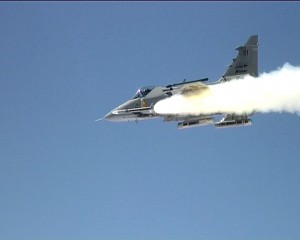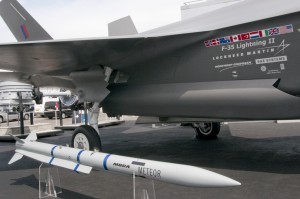2013-04-08 Recently, we released a report on what we are calling a 21st Century weapons enterprise.
We are focusing on the impact of new relationships among 5th generation aircraft, weapons and robotics, which can reshape how platforms operate together and how strike is delivered.
At the heart of the change is the emergence of a distributed strike enterprise. Rather than seeing strike concentrated in core platforms or configurations like the Carrier Battle Group, what we will see over time is the distribution of C2 and strike throughout a fleet or a force. This will allow a force to provide for presence, and to defend or attack seamlessly.
This is part of what Secretary Wynne has called an attack and defense enterprise.
With the new multi-mission systems, the key is presence and integration able to support strike or defense in a single operational presence capability. Now the adversary cannot be certain that you are simply putting down a marker.
The strategic thrust of integrating modern systems is to create a grid that can operate in an area as a seamless whole, able to strike or defend simultaneously.
This is enabled by the evolution of C5ISR (Command, Control, Communications, Computers, Combat Systems, Intelligence, Surveillance, and Reconnaissance), and it is why Wynne has underscored for more than a decade that fifth generation aircraft are not merely replacements for existing tactical systems but a whole new approach to integrating defense and offense….
By shaping a C5ISR system inextricably intertwined with platforms and assets, which can honeycomb an area of operation, an attack and defense enterprise can operate to deter aggressors and adversaries or to conduct successful military operations.
Shaping an appropriate weapons revolution to go along with the 5th generation aircraft is not simply about arming particular platforms, it is about re-thinking the entire approach to combat.
It is about how to build combat synergy across a fleet – joint and allied.
Core Aspects of a New Weapons Enterprise
The perspective presented above suggests a number of key elements for weapons in the next phase of air combat development.
- First, the key capabilities of the 5th generation aircraft should define the weapons and not the other way around.
- Second, offloading of weapons will be a fundamental opportunity posed by the 5th generation aircraft.
- Third, the ability to craft synergy across a legacy fleet enabled by 5th generation fighters will be a significant aspect of combat capability.
- Fourth, one USMC aviation thinker has suggested that the F-35 might best be armed internally with defensive weapons, and leverage other platforms for offensive and strike purposes.
- Fifth, weapons themselves could be redesigned to take into account the operational impact of the fusion engine of the F-35.
- Sixth, another key aspect of the next phase of weapons development is the cross-fertilization of the performance of the F-35 cockpit with the robotics revolution.
- Seventh, software upgradeability will be a key aspect of how to evolve the weapons revolution.
- Eighth, the weapons integration approach of the F-35 if exercised properly could revolutionize not only integration but the ability of a global coalition to develop economies of scale and diversity of choice never open before.
It is about maximizing global investment.
It is also about plugging in a diversity of global experiences into a much more capable fleet of aircraft.
Each country will shape its integration of the F-35 with its national forces a bit differently and in so doing may well seek weapons, which fit its core requirements. With a global approach, subsets of countries could buy similar weapons to deal with convergent con-ops requirements.
A 360-degree aircraft deserves a global weapons development and diversity approach.
Again the core image is how the platforms work with the weapons to shape what we have called a honeycomb force that is robust in its operational area and foundational for mix and match plug-in capability. It is scalable and able to add significant combat capability as needed and as appropriate to the mission.
The Meteor Case
Rolling off the production line in Europe is a new weapon appropriate to the 21st Century weapons enterprise. The Meteor missile has several core capabilities, which provide a case study of 21st century capabilities. It is often described as a new or longer-range replacement for AMRAAM but it really is not well described in those terms.

We should note that longer range is crucial for a combat aircraft with a significantly greater radar reach than the current AMRAAM, and the Meteor certainly is considerably more appropriate than the traditional AMRAAM for the F-35.
We have posted a White Paper on the Meteor from material publically available from MBDA, the prime contractor for the Meteor missile. Let us start with this baseline and then discuss the weapon differently, namely from a 21st century point of view.
A White Paper on the Missile
The new Meteor missile developed by MBDA is a representative of a new generation of air combat missiles for a wide gamut of new air systems.
It can be fitted on the F-35, the Eurofighter Typhoon, Rafale, Gripen and other 21st century aircraft.
The Background Environment
Increasing proliferation of state-of–the-art air-to-air threats is a critical challenge for modern Air Forces answered by METEOR;
METEOR is being developed to meet the requirements of six European nations (UK, Italy, Spain, Germany, Sweden and France) for a superior Beyond Visual Range (BVR) missile system with the operational capability to excel in all current and future combat scenarios;
This collaboration of six European nations provides access to technology and expertise from across Europe.
The range and performance of the Meteor and its ability to enable both old and new air systems moves air to air weapons into the next generation.
What is METEOR and what are its benefits?
- A fast and highly maneuverable Beyond Visual Range air-to-air weapon
- Largest No Escape Zone of any air-to-air weapon resulting in a long stand-off range and high kill probability to ensure air superiority and pilot survivability;
- Guidance is provided by an active radar seeker benefiting from enhanced technologies drawn from MBDA’s advanced seeker programmes;
- Capable of engaging air targets autonomously by night or day, in all weather and in severe electronic warfare environments;
- Equipped with both a proximity and impact fuse to ensure total target destruction in all circumstances.
METEOR will be integrated onto several major platforms:
- Eurofighter Typhoon;
- Saab Gripen; and
- Dassault Rafale
- Potential to add to the air-to-air capability of other combat platforms including the F-35 Joint Strike Fighter
Meteor provides a step change in capability.
For a brochure explaining the Meteor see below:
https://sldinfo.com/whitepapers/the-coming-of-the-meteor-missile/
The Meteor as a 21st Century Weapon
There are a number of aspects of the Meteor program, which are inherent to a 21st century weapons enterprise. In this section, we will discuss some of these aspects. This analysis is designed to illustrate and be suggestive, not providing a complete or comprehensive look at the Meteor program.
At the heart of the Meteor program is an integrated development team led by the prime contractor, MBDA. The missile was developed to meet the operational requirements of 6 partner nations and for 3 very different combat aircraft, the Eurofighter Typhoon, the Rafale and the Gripen. It is also compatible with the F-35 weapon bay.
Frequently, a multi-national program is more of a problem than a solution. In this case, the challenge of building for multiple aircraft and partners at the same time, has given the MBDA team a leg up on the 21st century. To design and build the missile, a comprehensive model was developed; this incorporated the various aspects of a successful missile, ranging from aircraft characteristics, to radar system performances, and the various operational scenarios,/operational styles of the different aircraft and air forces.
This has meant that MBDA has forged a very robust model for development, which is then at the heart of the production of the missile itself. The missile is software upgradeable so that changes over time will be written into the code in the model and directly incorporated into production runs.

Software upgradeability is a game changer for 21st century systems not well understood or highlighted by analysts. In the past, new products would be developed to replace older ones in a progressive but linear dynamic. But now, one builds a core product with software upgradeability built in, and as operational experience is gained, the code is rewritten to shape new capabilities over time. Eventually, one runs out of processor power and BUS performance and needs to consider a new product, but with software upgradeability, the time when one needs to do this is moved significantly forward in time.
It also allows more rapid response to evolving threats. As threats evolve, re-programming the missiles can shape new capabilities, in this case the Meteor missile. The current production missile is believed to be using well below the maximum processing power and bus capacity of the missile. Significant upgradeability is built in from the beginning.
Although software upgradeability is not new with regard to weapon systems, the F-35 as a software upgradeability is.
Combining the launch of a software upgradeable aircraft with a missile designed from the ground up with upgradeability built in will allow the aircraft and the weapon to evolve together over time to deal with evolving threats and challenges.
And underlying the model and the code is a multinational team. And this team is the core capability, which can drive weapons development over time. MBDA has functioned as the prime and has worked with three aircraft manufacturers and radar manufacturers already and is working with additional players as the missile prepares to go onto the F-35.
What has been a challenge – working with 6 air forces – is an opportunity as well. Each of the partners had different takes on the target set they wished the missile to serve. This has meant that the range of targets and engagement envelopes were very wide ranging, from low-level cruise missiles and high flyers, to UAVS, to helos, etc. The end result is a software upgradeable missile with a very wide-ranging initial capability to deal with a diversity of targets
Another key aspect of the missile is it is designed from the beginning to be employed on and off-board. It can be fired by one aircraft and delivered to target by that aircraft or the inflight data link can be used via another asset – air or ground based – to guide it to target.
The missile ought to be integrated into the Block 4 of F-35.
When so done, the missile can provide a sweet spot of 4th and 5th generation weapons integration with its core networking capability.
Because of the nature of software integration on the F-35, the Meteor missile, which will be integrated onto the F-35 due to European requirements, means that it is available to all the other global partners of the F-35 as well.
The partner aspect is crucial in leveraging global investments of America and its partners in a resource-constrained age.
The MBDA approach has implications for testing as well. The US is in what Secretary Wynne calls an “over test” regime, which keeps testers employed but does not take into account 21st century technologies for development, which incorporate modern test procedures. The prime contractor’s missile model used in development and production of the Meteor missile was used as the evolving baseline and tests are made against the baseline to verify the model, not just to do tests to keep testers in business.
MBDA and its partners have confidence in 21st development technologies, something which the Inside the Beltway discussion of testing has lost sight of.
In short, the Meteor missile is a harbinger of things to come, if analysts and policy makers can really understand the nature of 21st technology, capabilities and approaches.

